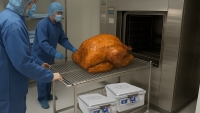Monday, 14 October 2024 13:39
The Dirty Truth About Endoscope Processing and What We Can Do To Fix It
There are 54 billion bacterial cells on a single cubic centimeter of the average kitchen sponge. They are breeding grounds for all types of germs and bacteria. A common sponge’s spatial partitioning – the way it’s divided into different sectors of various sizes with a porous absorbent surface – caters to bacteria that prefer isolated environments and those that prefer to be around other organisms as well, making it the best of both worlds for microbial communities...
Published in
News





